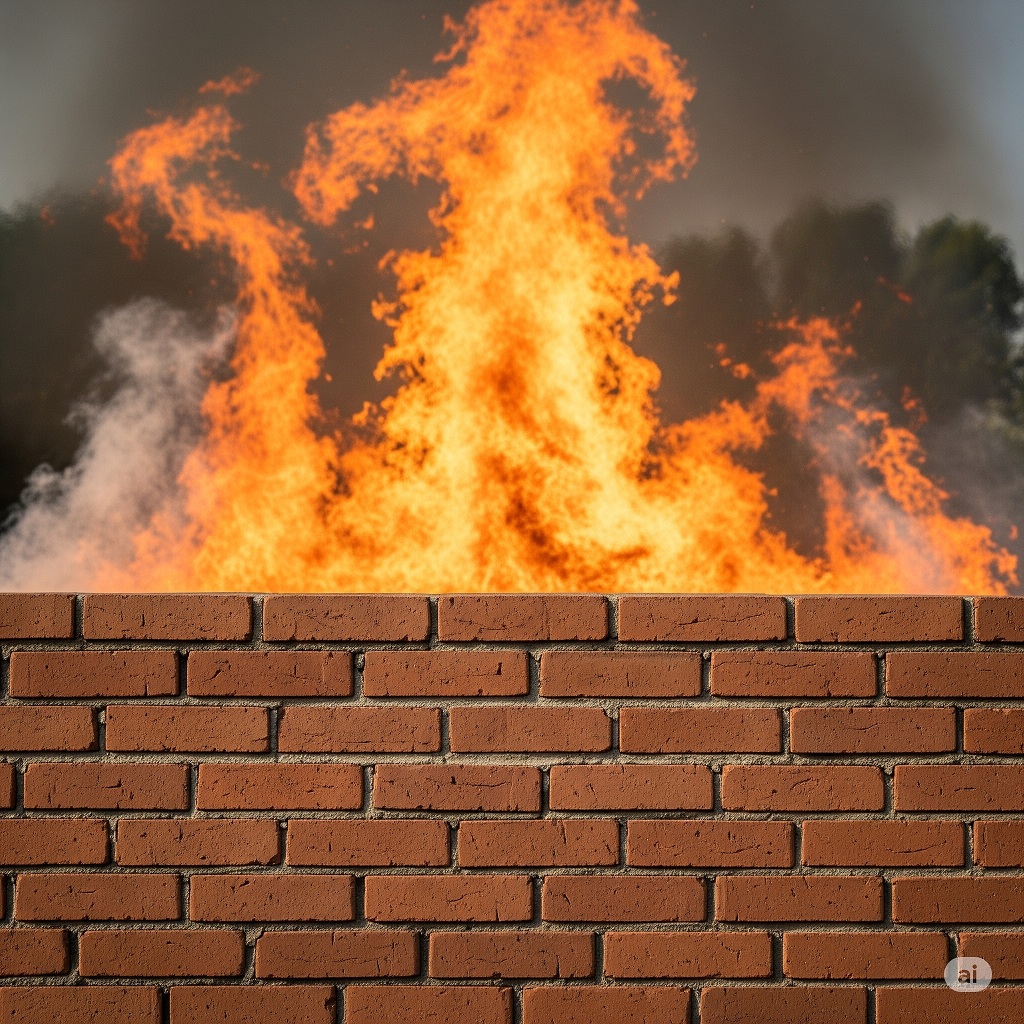
While bricks are indeed known for their durability and fire resistance, claiming that they are entirely fireproof would be a stretch. Understanding the factors that influence a brick’s ability to withstand fire is crucial for anyone looking to build or renovate with this material. Join me as I uncover the truth about the fireproof qualities of bricks and provide valuable insights for your next construction project.
When it comes to building materials that stand the test of fire, bricks are often considered the go-to solution. From ancient kilns to modern firewalls, bricks have built a reputation for withstanding the flames. But are bricks truly fireproof? Or is it a myth rooted in misunderstanding?
Let’s dive into the science, construction practices, and fire testing standards to reveal the truth.
🔍 What Does “Fireproof” Really Mean?
Before we can evaluate bricks, we need to define what “fireproof” means in the context of building materials. In technical terms:
🔥 Fireproof means a material will not combust, will not melt, and will not contribute to fire spread or fuel.
However, most fire safety professionals use the term fire-resistant instead. This is because no material is completely immune to the effects of extreme heat over time.
Key Definitions:
- Fireproof: Capable of withstanding direct fire without combusting or significant structural damage.
- Fire-resistant: Can resist fire to a certain degree for a specified duration (e.g., 1 hour, 4 hours).
- Non-combustible: Does not ignite or burn.
So, is brick fireproof? Let’s take a look at the material science.
🧱 What Are Bricks Made Of?
Most traditional bricks are made from clay, shale, or concrete. These materials are non-combustible and have extremely high melting points—far above what is typically seen in building fires.
Common Brick Types:
| Brick Type | Composition | Fire Resistance | Notes |
|---|---|---|---|
| Clay Bricks | Natural clay, fired in kilns | High | Traditional and widely used |
| Concrete Bricks | Cement, sand, and gravel | Very High | Often used in commercial structures |
| Firebricks (Refractory) | Special refractory clay with alumina | Extremely High | Designed for furnaces and kilns |
These bricks are pre-fired at temperatures between 1,000°C to 1,200°C, meaning they’ve already survived hotter conditions than most structural fires.
🔥 Brick Behavior in Real Fires
Bricks are known to perform remarkably well under fire conditions due to:
- High heat tolerance (often above 2,000°F)
- Non-combustibility
- Thermal mass (slows fire spread)
- Low thermal conductivity (insulates fire-affected areas)
Even in intense structure fires, bricks typically remain intact and may only suffer surface discoloration or cracking. The mortar between bricks is more likely to deteriorate before the bricks themselves.
However, not all bricks behave the same. Let’s look at a few examples:
🧪 Fire Performance by Brick Type (Chart)
| Brick Type | Melting/Softening Point | Fireproof Rating | Used In |
|---|---|---|---|
| Clay Brick | 1,000°C – 1,200°C | High | Exterior and load-bearing walls |
| Concrete Brick | 1,100°C | Very High | Commercial buildings |
| Fly Ash Brick | 900°C – 1,000°C | Medium-High | Eco-friendly homes |
| Firebrick (Refractory) | 1,400°C – 1,800°C | Extremely High | Fireplaces, kilns |
| Adobe Brick | 500°C – 700°C | Low-Medium | Earth homes |
| Glass Brick | ~500°C | Low | Decorative use only |
🔍 Myth vs. Reality
🔴 Myth: Bricks Can’t Be Damaged by Fire
✅ Reality: Bricks can suffer surface cracking, chipping, and mortar degradation under prolonged or extremely intense fires. While they don’t catch fire, they are not invincible.
🔴 Myth: All Bricks Are the Same in Fire Performance
✅ Reality: Firebricks are specially made for high-temperature environments, while adobe or decorative bricks may degrade much faster.
🔴 Myth: Brick Homes Are Completely Fireproof
✅ Reality: The structure behind the brick façade (e.g., wood framing, insulation, roofing) can still burn, allowing the fire to spread internally even if the outer bricks remain intact.
🏗️ Building Codes and Brick Fire Ratings
Fire resistance ratings are a crucial part of any building code. Bricks are evaluated according to standards such as:
- ASTM E119 (Standard Test Methods for Fire Tests of Building Construction and Materials)
- NFPA 221 (Standard for High Challenge Fire Walls)
Typical Ratings:
- 4-inch clay brick wall: ~1-hour fire resistance
- 8-inch solid masonry wall: ~2-4 hour rating
- Firebrick-lined structures: 4+ hours or continuous high-temp exposure
Bricks not only meet but often exceed fire resistance code requirements for residential and commercial buildings.
🔥 Real-World Examples of Brick Resilience
- 🔸 Grenfell Tower Fire (London, 2017): The outer brick walls withstood the heat better than aluminum composite panels, which ignited.
- 🔸 California Wildfires: Brick chimneys and walls often remain standing after wooden homes are destroyed.
- 🔸 Historical Castles: Many centuries-old structures with brick and stone walls still stand despite past fires and sieges.
🔧 Common Fire-Related Issues with Brick Walls
Despite their strength, bricks can still be affected:
| Issue | Cause | Solution |
|---|---|---|
| Spalling | Rapid heating → steam pressure | Use fire-rated bricks & mortar |
| Mortar degradation | Heat breaks down binder | Repoint with fire-resistant mortar |
| Cracks or fractures | Extreme or uneven heat | Firebrick repair, structural assessment |
| Structural instability | Weakness in backing structure | Reinforce with concrete or fire-rated assemblies |
🧯 Where Bricks Excel in Fire Safety
- Firewalls & fire-rated walls: Bricks form natural fire barriers between units or rooms.
- Fireplace linings: Firebricks withstand continuous high temperatures.
- Chimneys: Masonry chimneys are safer than metal alternatives.
- Pizza ovens, kilns, and forges: Firebrick-lined for maximum heat protection.
🧠 Conclusion: So, Are Bricks Truly Fireproof?
Yes and no.
Bricks are non-combustible, highly fire-resistant, and don’t release toxic fumes. They are among the most fire-resilient materials used in construction. However, calling them 100% “fireproof” is misleading because:
- Bricks can crack or spall under extreme heat.
- Fire can still penetrate through joints, windows, or wooden framing.
- The effectiveness depends on brick type, installation, and construction design.
So while bricks are one of the best defenses against fire, no material is truly impervious to fire in all circumstances.
🔎 Related FAQs
❓1. Can bricks catch fire?
No. Bricks are made of non-combustible materials like clay or concrete and will not ignite.
❓2. What type of brick is best for fire resistance?
Firebrick (refractory brick) is specifically engineered for extreme heat and used in kilns and fireplaces.
❓3. Will regular clay bricks survive a house fire?
Yes, usually. They may suffer cosmetic damage, but the structural integrity is often preserved.
❓4. Do bricks explode in fire?
They can spall (chip or crack) if moisture inside expands rapidly. Dry, well-fired bricks usually do not explode.
❓5. How long can a brick wall resist fire?
Depending on thickness, brick walls can resist fire from 1 to 4 hours or more.
❓6. Are brick homes safer in wildfires?
Yes. Brick exteriors resist ignition and help slow fire spread, though windows and roofs remain vulnerable.
❓7. Is concrete more fireproof than brick?
Both are excellent. Concrete may degrade faster at very high temps, while brick holds form better in many cases.
❓8. Can you reuse bricks after a fire?
If they are not cracked or degraded, bricks can often be salvaged and reused after cleanup.
❓9. Why do some brick buildings burn down?
While bricks resist fire, internal materials like wood framing, insulation, and roofing can burn.
❓10. Are brick veneers fire-rated?
Not usually. Brick veneer is thin and decorative—it does not offer the same fire resistance as full-thickness masonry.
